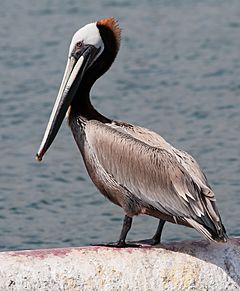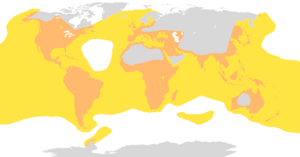Pelecaniformes facts for kids
Quick facts for kids Pelecaniformes |
|
|---|---|
 |
|
| Brown Pelican (Pelecanus occidentalis) | |
| Scientific classification | |
| Kingdom: | |
| Phylum: | |
| Class: | |
| Infraclass: | |
| Order: |
Pelecaniformes (disputed)
Sharpe, 1891
|
| Families | |
 |
|
| Global Distribution of the Pelecaniformes. | |
The Pelecaniformes are a group of medium-sized and large waterbirds. They live all over the world. These birds have a special feature: all four of their toes are connected by webbing. This helps them swim well.
Contents
Unique Features of Pelecaniformes
Most Pelecaniformes birds have a bare patch of skin on their throat. This is called a gular patch. It can sometimes look like a pouch.
How They Breathe
Unlike many other birds, Pelecaniformes have special nostrils. Their nostrils have changed over time into small slits. These slits do not work very well for breathing. Because of this, these birds usually breathe through their mouths.
What Pelecaniformes Eat
These birds are skilled hunters in the water. They mostly eat fish and squid. They also feed on other small marine animals they find in the ocean or fresh water.
Life Cycle and Young Birds
The baby birds of Pelecaniformes are born in a special way. They are called altricial young. This means they hatch from their eggs very helpless. Most of them are born naked, without feathers. They cannot take care of themselves right away.
Parental Care
Adult Pelecaniformes do not have a brood patch. A brood patch is a bare area on a bird's belly that helps keep eggs warm. Even without this, the parents still care for their young. They feed and protect their babies until they are old enough to survive on their own.
See also
 In Spanish: Pelecaniformes para niños
In Spanish: Pelecaniformes para niños

